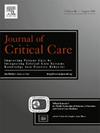急性脑损伤有创通气患者呼气末正压(PEEP)与拔管失败和临床结果的关联:ENIO研究的二次分析
IF 2.9
3区 医学
Q2 CRITICAL CARE MEDICINE
引用次数: 0
摘要
背景:有创机械通气(IMV)对于治疗急性脑损伤(ABI)患者至关重要,但呼气末正压(PEEP)对预后的影响尚不清楚。本研究旨在评估ABI患者PEEP水平与拔管失败风险以及重症监护病房(ICU)死亡率之间的关系。方法:对ENIO研究的事后分析纳入了来自ENIO队列的1512例ABI患者,排除了第1天没有PEEP数据和从未接受过拔管试验的患者。分别于拔管第1、3、7天及拔管当天记录PEEP水平。Logistic回归评估PEEP与拔管失败之间的关系,Cox比例风险回归分析ICU死亡率。结果:1154例患者拔管失败发生率为21.2%,ICU死亡率为3.7%。第1,3和7天较高的中位PEEP与拔管失败的优势比(OR)增加独立相关(OR = 1.13; 95% CI = 1.01-1.26; p = 0.0294)。拔管时,较高的PEEP也与拔管失败(OR = 1.13; 95% CI = 1.02-1.25; p = 0.0218)和ICU死亡率显著相关(HR = 1.38; 95% CI = 1.12-1.69; p = 0.0026)。然而,在调整急性呼吸窘迫综合征(ARDS)的敏感性分析中,PEEP不再与结果显著相关,而ARDS本身是拔管失败的独立预测因子。结论:高PEEP拔管ABI患者拔管失败和ICU死亡风险增加相关。然而,这种关联可能反映了潜在的呼吸病理或疾病的严重程度。我们的研究结果表明,PEEP水平可以作为拔管准备程度的替代指标,而不是可改变的风险因素,并强调拔管前需要进行个体化评估。本文章由计算机程序翻译,如有差异,请以英文原文为准。
Associations of positive end-expiratory pressure (PEEP) with extubation failure and clinical outcomes in invasively ventilated patients with acute brain injury: A secondary analysis of the ENIO study
Background
Invasive mechanical ventilation (IMV) is crucial for managing acute brain injury (ABI) patients, yet the effects of positive end-expiratory pressure (PEEP) on outcomes are not well understood. This study aimed to evaluate the relationship between PEEP levels and risk of extubation failure as well as intensive care unit (ICU) mortality in ABI patients.
Methods
This post-hoc analysis of the ENIO study included 1512 ABI patients from the ENIO cohort, excluding those without available data on PEEP at day 1 and who never received an extubation trial. PEEP levels were recorded at days 1, 3, 7, and on the day of extubation. Logistic regression assessed the association between PEEP and extubation failure, while Cox proportional hazards regression analyzed ICU mortality.
Results
Among 1154 included patients, extubation failure occurred in 21.2 % and ICU mortality was 3.7 %. Higher median PEEP at days 1, 3, and 7 was independently associated with increased odds ratio (OR) of extubation failure (OR = 1.13; 95 %CI = 1.01–1.26; p = 0.0294). At the time of extubation, higher PEEP was also significantly associated with extubation failure (OR = 1.13; 95 %CI = 1.02–1.25; p = 0.0218) and ICU mortality (Hazard Ratio, HR = 1.38; 95 %CI = 1.12–1.69; p = 0.0026). However, at sensitivity analyses adjusted for acute respiratory distress syndrome (ARDS), PEEP was no longer significantly associated with outcomes, while ARDS itself was an independent predictor of extubation failure.
Conclusions
Extubating ABI patients at higher PEEP levels was associated with an increased risk of extubation failure and ICU mortality. However, this association likely reflects underlying respiratory pathology or disease severity. Our findings suggest that PEEP level may serve as a surrogate marker for extubation readiness, rather than a modifiable risk factor, and highlight the need for individualized assessment prior to extubation.
求助全文
通过发布文献求助,成功后即可免费获取论文全文。
去求助
来源期刊

Journal of critical care
医学-危重病医学
CiteScore
8.60
自引率
2.70%
发文量
237
审稿时长
23 days
期刊介绍:
The Journal of Critical Care, the official publication of the World Federation of Societies of Intensive and Critical Care Medicine (WFSICCM), is a leading international, peer-reviewed journal providing original research, review articles, tutorials, and invited articles for physicians and allied health professionals involved in treating the critically ill. The Journal aims to improve patient care by furthering understanding of health systems research and its integration into clinical practice.
The Journal will include articles which discuss:
All aspects of health services research in critical care
System based practice in anesthesiology, perioperative and critical care medicine
The interface between anesthesiology, critical care medicine and pain
Integrating intraoperative management in preparation for postoperative critical care management and recovery
Optimizing patient management, i.e., exploring the interface between evidence-based principles or clinical insight into management and care of complex patients
The team approach in the OR and ICU
System-based research
Medical ethics
Technology in medicine
Seminars discussing current, state of the art, and sometimes controversial topics in anesthesiology, critical care medicine, and professional education
Residency Education.
 求助内容:
求助内容: 应助结果提醒方式:
应助结果提醒方式:


